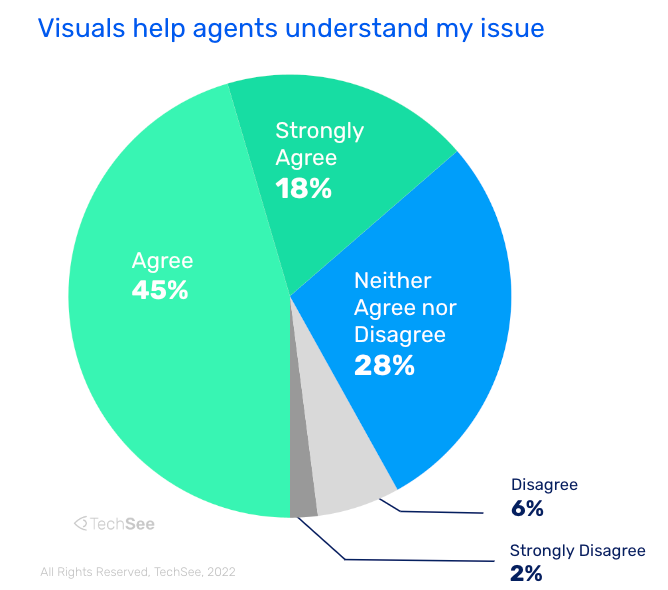Removing the Fear of Computer Vision & AI Among Customer Service Teams
By David Troll, TechSee
According to Accenture research, 75% of C-suite executives fear going out of business entirely if they don’t scale AI in the next five years1. However, the same report highlighted that 76% of the executives surveyed indicated they struggle with how to scale.
When I speak with business leaders, it is apparent that there is still a degree of uncertainty and even fear about adopting AI solutions. Are we ready for it with our current tech stack? Will our people be able to embrace these new technologies with their existing equipment and skills? Are customers really eager (or even ready) for these solutions? It can become overwhelming very quickly.
 As a leading computer vision AI solution provider, one key role we play in the industry is dispelling myths and mitigating this fear of the unknown, especially about how new technology is being received. While the technology underpinning these solutions is extremely sophisticated, anyone can enjoy the benefits of customer or employee engagement channels that include a visual component, with or without AI-powered automation.
As a leading computer vision AI solution provider, one key role we play in the industry is dispelling myths and mitigating this fear of the unknown, especially about how new technology is being received. While the technology underpinning these solutions is extremely sophisticated, anyone can enjoy the benefits of customer or employee engagement channels that include a visual component, with or without AI-powered automation.
You are interacting with AI every day, and might not even realize it. Your phone’s camera, your car’s driver assistance and the phone system you speak with when calling your bank or airline often include some of these advanced capabilities and are used by billions of people who don’t know, or need to know the engineering efforts behind them - you can just reap the benefits.
As customer expectations continue to rise, and the demands on support teams grows with it, organizations such as contact centers and field service departments are quickly discovering how essential these solutions can be. Customer interactions can become far more efficient and effective by offering diverse channels and self-service, as well as remote engagement. For example, a contact center agent is now able to identify a product model instantly with visual recognition technology, without having to ask a customer to find and read a 20 character alpha-numeric serial number.
These enhancements dramatically improve the bottom line. As interactions are streamlined, this leads to happier customers and faster resolution time as well as fewer follow up calls. These efficiencies, for large companies, can amount to tens of millions of dollars in annual savings. Yet the impact of adopting these technologies goes well beyond cost reduction. A better overall customer experience can be a powerful differentiator to make a brand stand out for all the right reasons. A recent report from McKinsey highlighted that 38% of executives plan to invest more in technology to make it their competitive advantage.2
CUSTOMERS ARE READY AND WILLING TO EMBRACE COMPUTER VISION
While there is sometimes doubt from organizations about their operational readiness to adopt general AI and specifically computer vision technologies, the market is ripe for change. Especially when it comes to customer service and support interactions, there is a significant communication gap, channel confusion and escalating customer frustration. Of course it is much harder to identify a problem that can’t be seen, which constrains contact center agents and often leads to (expensive!) in-person visits from field technicians for issues that could have been solved remotely. It can be challenging for customers to explain the nature of a problem, remember the exact model they bought, or articulate what they have tried to address the issue. This leads to a lot of time spent, and patience required, on both sides, and often forces multiple follow-up calls or technician visits.
A new survey about the state of customer service unsurprisingly shows that 44% of US customers are dissatisfied with agent-provided service.3 And it’s not just the human element that frustrates people. The same research shows that 67% of these customers are also dissatisfied with self-service solutions such as automated bots. In the end, the frustration comes from not having issues addressed quickly and efficiently. Of course, this has a huge impact on brand loyalty and affinity.
There is a direct link between customer satisfaction and brand loyalty. In 2022, 43% of customers switched products or canceled a contract due to poor customer service.4 It is important to take into account the cost of these inefficient interactions, which hemorrhage enormous sums from large enterprises, needing more staff to handle millions of unnecessary calls and field visits that could have been solved with the help of visually-enriched engagements. This is without factoring the tens of millions of dollars that businesses might be losing as a result of damaged brand reputation from dissatisfied customers. In the US alone, the estimated cost of customers switching due to poor service is $1.6 trillion annually.5
PUTTING VISUAL INTELLIGENCE AT THE HEART OF CUSTOMER INTERACTION
The rise of universal internet access and especially smartphones over the past 20 years has ushered in a new era of visual communications. From Zoom meetings to pervasive picture and video sharing via Instagram and TikTok to watching a live map along with other drivers and their status and updates while navigating, we have added a visual layer to our daily routine.
Unsurprisingly, new research found that when it comes to customer service interactions, US customers prefer visual instruction over both textual and verbal instruction. 63% of customers are open to submitting pictures in order to receive faster resolution, and feel that the service experience would be improved by providing visual context to their agent. A similar amount of respondents (65%) are open to receiving visual guided instructions if it will help solve their issues more quickly.3
 The demand for guided support by leveraging visual intelligence is significant and growing. People understand that visual collateral, whether in the form of shared images, live video, or even self-service visual AI, can be a solution to many frustrating misunderstandings that take place over the phone, via email, or through bots. In 2022, as many as one in three customers say they are not understood by a support agent when explaining their problem verbally. Quick problem resolution is essential, with 35% of customers in a Microsoft survey saying that resolving issues in one interaction should be a priority for the customer support team.6
The demand for guided support by leveraging visual intelligence is significant and growing. People understand that visual collateral, whether in the form of shared images, live video, or even self-service visual AI, can be a solution to many frustrating misunderstandings that take place over the phone, via email, or through bots. In 2022, as many as one in three customers say they are not understood by a support agent when explaining their problem verbally. Quick problem resolution is essential, with 35% of customers in a Microsoft survey saying that resolving issues in one interaction should be a priority for the customer support team.6
DEMOCRATIZING COMPUTER VISION & AI THROUGH SIMPLER DEPLOYMENTS
Organizations are typically aware about the importance of modernizing and digitizing their customer service practices. What they’re often not aware of is how to incorporate new technologies like compute vision AI (CVAI) that have become sophisticated and accurate enough to offload meaningful work from support agents and field technicians. Some CVAI solutions are not only field tested but are also relatively simple to design, develop and deploy across the business.
The term “digital transformation” has emerged over the past few decades and the role of a digital transformation leader has become a key player in many companies’ success. These people often champion the efforts to modernize by selecting the right technologies and tools, and to help lead change management within their organization. This includes everything from researching to procurement to creating the right training programs to upskill their workforce. Before most organizations are ready for transformation, they typically experiment with an innovation team or department, testing and learning until they decide on how best to proceed. Many companies struggle with this transition, from piloting new innovations to scaling and truly transforming.

And the scale of these efforts is massive! By 2023, IDC estimates that global spending on services and technologies to enable digital transformation will amount to $2.3 trillion.7 Moreover, the focus of much innovation and transformation is, as you would expect, on an improved customer experience. In fact, recent research suggests that as much as 37% of all IT initiatives by companies worldwide are focused on improving CX.8
To accelerate this transition and achieve the desired outcomes, AI and computer vision solutions need to be accessible, both to companies and their customers. While the underlying technology is incredibly complex, from an end-user perspective it can (and should) be as simple as using your camera phone to scan a barcode or recognize a device to begin a service interaction, and even show
step-by-step instructions to the customer, agent or technician, just like a navigation app for driving.
As always, new technology needs time to mature. The high aspirations of the innovation phase are often met with false starts and failed initiatives. But as the technology matures and is proven in live production environments, more often than not, it is psychological resistance that makes people skeptical about adopting new capabilities. Building AI solutions is quite challenging, but change management can be even more so. Part of my role as an industry insider is to help companies through this transition. Having been through several industry cycles, including the shift to SaaS in the mid-2000s, and both Workforce Automation and Mobile soon after, the pattern is clear: it is our responsibility to provide not only effective solutions but also the roadmap for how to deploy them to employees and customers.
Fortunately, most of us already are familiar with these technologies, carrying them around in the palm of our hands every day. That familiarity along with the advice of our successful clients who made the leap, can help provide the needed guidance and affirmation as new companies, industries and use cases develop. This is all very timely as the increasing expectations from customers cannot be addressed with the last generation’s tools. Visual engagement, and especially visual self-service powered by Computer Vision and AI, are essential ingredients in the practical digital transformation that will give brands a customer-centric edge.

References
1. AI: Built to Scale, Accenture 2019
2. How COVID-19 has pushed companies over the technology tipping point—and transformed business forever, McKinsey, 2020
3. 2022 State of The Service Market Survey Report, TechSee, 2022
4. 2022 State of Customer Loyalty & Churn Survey Report, TechSee, 2022
5. U.S. Companies Losing Customers As Consumers Demand More Human Interaction, Accenture, 2016
6. Global State of Customer Service, Microsoft, 2021
7. Worldwide Digital Business Spending Guide, IDC, 2021
8. Tech Spend Pulse, Flexera, 2022
 David Troll
David TrollDavid has over 25 years of experience leading enterprise growth and change initiatives, both as a consultant and operating executive. He has helped hundreds of companies worldwide evaluate, implement and optimize solutions that enhance their customer engagement and improve operational effectiveness. David was previously the VP for DISH Network’s OnTech smart home division, which provides the in-home service for tier 1 brands like Google/Nest, Amazon/Ring, and others. Before that, David ran global sales, delivery and service for location platform Glympse which offers enhanced customer journeys for home service and curbside pickup, and held several executive roles at field service leader TOA Technologies (now Oracle Field Service).